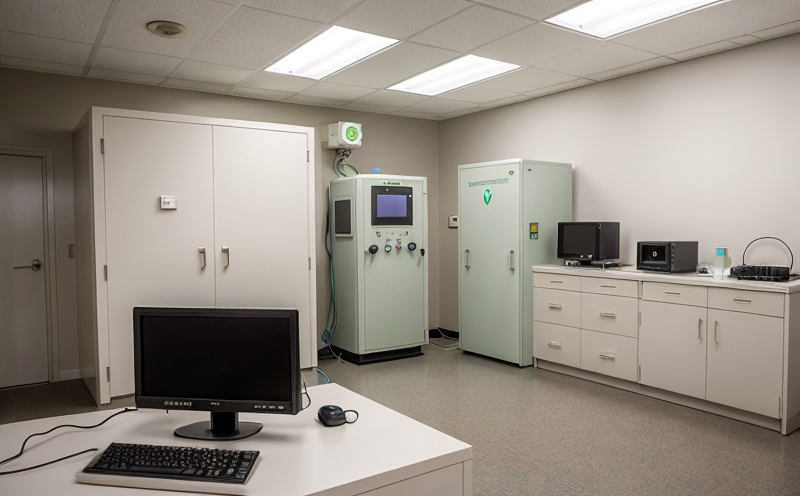ASTM E666 Testing of Thermoluminescent Dosimeters (TLDs)
The ASTM E666 standard provides a comprehensive framework for testing thermoluminescent dosimeters (TLDs), which are widely used in radiation monitoring and nuclear safety applications. TLDs capture the energy absorbed by materials over time, storing it as latent luminescence until subjected to controlled heating. This process allows for precise measurement of the absorbed dose, making TLDs indispensable tools in radiation dosimetry.
The ASTM E666 method is particularly valuable in industries such as nuclear power, medical physics, and environmental protection. It ensures that TLDs are accurate, reliable, and capable of providing consistent results across various testing scenarios. The standard covers the entire lifecycle of TLDs, from pre-activation to post-processing, ensuring that each step contributes to the overall accuracy and reliability of dose measurements.
Pre-activation involves exposing the TLDs to a known radiation source in controlled conditions. This step is crucial as it initializes the dosimeter to measure accurately during use. Activation typically occurs by heating the TLDs under specific conditions, which releases the stored energy. The luminescence emitted is then quantified using specialized instrumentation.
The ASTM E666 protocol also specifies post-processing steps that are essential for data interpretation and accuracy. These include calibration of the dosimeters against known radiation sources and ensuring that all measurements are traceable to international standards such as ISO 18359:2017, which governs the performance requirements for TLDs.
The importance of ASTM E666 testing cannot be overstated. It ensures compliance with regulatory requirements and provides a robust foundation for trust in radiation monitoring systems. Industries that rely on accurate dose measurements can benefit from consistent and reliable results, enhancing safety and operational efficiency.
In summary, ASTM E666 is more than just a technical standard; it represents best practices in the field of radiation dosimetry. By adhering to this method, laboratories ensure that TLDs are used effectively, reliably, and accurately across various applications.
Why It Matters
The accuracy and reliability of thermoluminescent dosimeters (TLDs) are critical in ensuring the safety and well-being of individuals exposed to radiation. In nuclear power plants, medical facilities, and other high-risk environments, accurate dose measurements can prevent overexposure, reduce risks, and comply with regulatory standards.
ASTM E666 testing is essential for several reasons:
- Regulatory Compliance: Ensures that dosimeters meet international standards and regulations.
- Risk Mitigation: Provides accurate dose data to minimize the risk of radiation exposure.
- Data Integrity: Guarantees consistent and reliable measurement results, enhancing trust in monitoring systems.
- Operational Efficiency: Ensures that dosimeters are functioning correctly, reducing downtime and operational costs.
The use of ASTM E666 testing is not limited to specific industries. It has broad applications across sectors such as nuclear power, medical physics, environmental protection, and more. In these fields, accurate dose measurements can significantly impact safety protocols, regulatory compliance, and overall operational efficiency.
Benefits
The benefits of ASTM E666 testing are multifaceted, offering significant advantages across various industries:
- Increased Safety: Ensures that radiation levels are accurately monitored, reducing the risk of overexposure.
- Regulatory Compliance: Meets international standards and regulatory requirements.
- Data Reliability: Provides consistent and accurate dose measurement results.
- Economic Efficiency: Minimizes downtime and operational costs by ensuring dosimeters are functioning correctly.
- Enhanced Reputation: Demonstrates a commitment to quality and safety, enhancing the reputation of businesses and organizations.
- Informed Decision-Making: Provides reliable data for informed decision-making in radiation management.
- Patient and Worker Protection: Ensures that medical staff and patients are protected from unnecessary exposure to radiation.
The comprehensive testing provided by ASTM E666 ensures that TLDs are fit for purpose, delivering accurate and reliable dose measurements. This is particularly crucial in environments where precise monitoring can make a significant difference in safety protocols and regulatory compliance.
Environmental and Sustainability Contributions
The use of ASTM E666 testing has far-reaching environmental and sustainability benefits:
- Reduced Exposure Risks: By accurately monitoring radiation levels, the risk of overexposure is minimized, protecting both workers and the environment.
- Sustainable Operations: Ensures that operations are conducted safely and efficiently, reducing the risk of accidents and incidents.
- Regulatory Compliance: Helps organizations comply with environmental regulations, contributing to a cleaner and safer world.
- Data-Driven Decisions: Provides reliable data for informed decision-making in radiation management, leading to more sustainable practices.
- Improved Safety: Ensures that workers are protected from unnecessary exposure to radiation, promoting a healthier environment.
In addition to these benefits, the accurate measurement of radiation levels can help identify areas where improvements can be made in terms of safety and efficiency. This contributes to a more sustainable future by reducing waste and improving operational practices.
By adhering to ASTM E666 testing protocols, laboratories play a vital role in promoting environmental sustainability. Their commitment to accuracy and reliability ensures that TLDs are used effectively, contributing to safer and more efficient operations across various industries.





